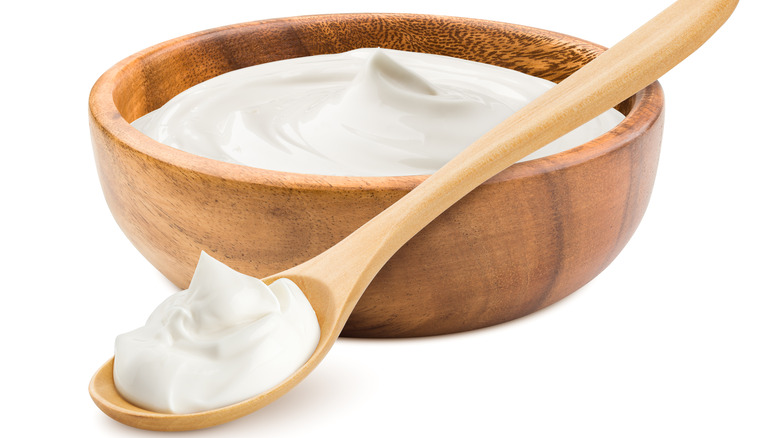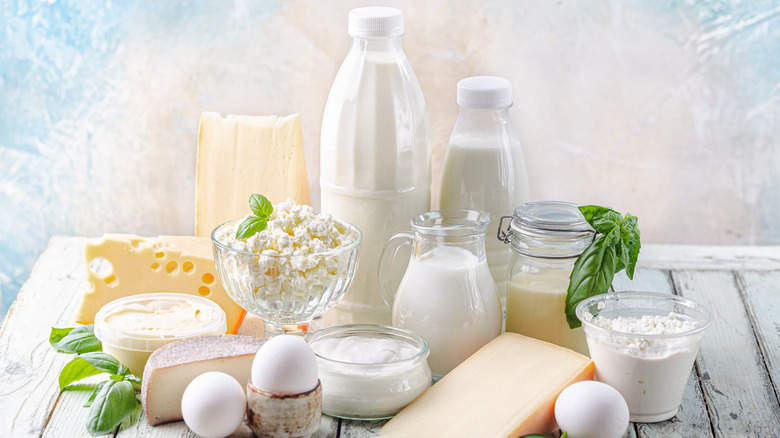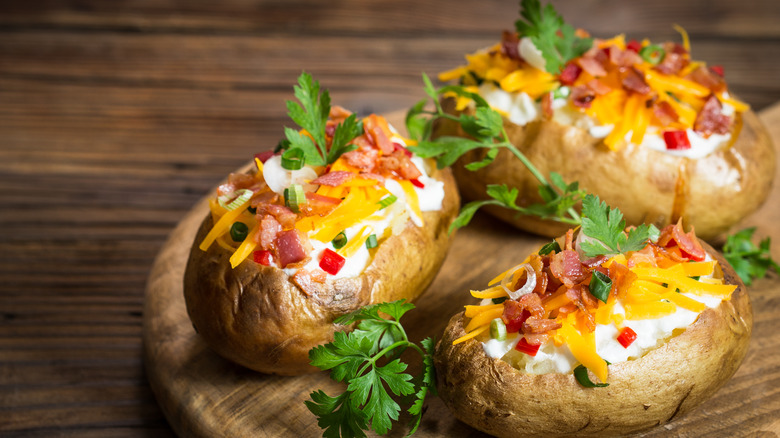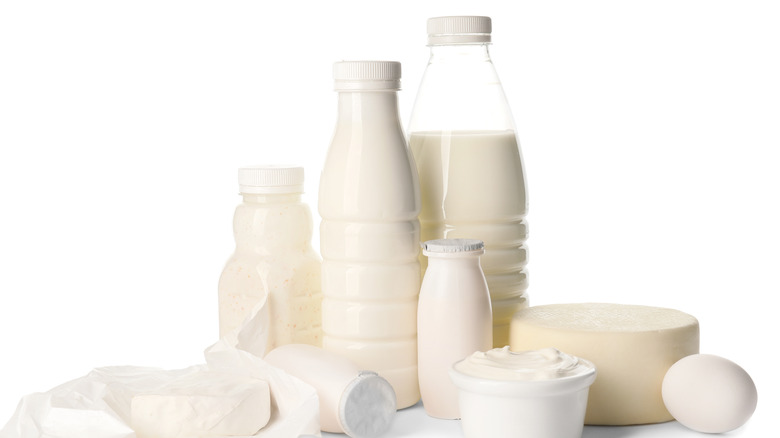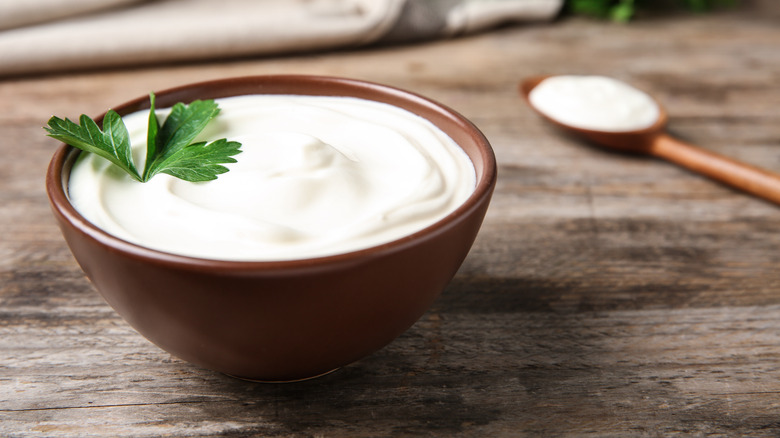Everything You Need To Know About Sour Cream
There are so many foods that double up to make sweet and savory dishes. Heavy cream, butter, mayonnaise, and many more. These smooth and yummy ingredients are added to so many dishes, it's hard to not have them in your kitchen at any given moment. One creamy item you should make sure is on your list of kitchen must-haves is sour cream.
Sour cream as we currently know it has been around for almost 50 years, says ifood.tv. It has been largely known to be cooked in meals from Eastern Europe, Germany, Ukraine, and Russia. Nowadays, though, you can add this sour-flavored dairy ingredient to just about any dish — including a whole lot of desserts.
With multiple brands and even low-fat or no-fat options, there are plenty of varieties for those who want to add it to a recipe. If you have had things like yogurt or cream cheese, your taste buds won't be too shocked when they first try sour cream.
What exactly is sour cream?
Sour cream's name doesn't exactly sound appealing, but it is a pretty good description of what it actually is. Sour cream is basically dairy cream with bacteria in it. Sounds great, doesn't it! But as we mentioned earlier, it is similar to yogurt, so don't be discouraged by the description.
The Spruce Eats describes how when lactic acid-producing bacteria appears in dairy cream, it will create a thick, tart flavored substance, which, you guessed it, is sour cream. Think of fermenting, the process of breaking down molecules, and that'll help you understand what is going on when sour cream is being made.
After this process is complete, it leaves a creamy topping or ingredient to cook with. As you may have figured out, sour cream is meant to be cold, just like heavy cream or creme fraiche. So, it should be popped into a fridge after being made or bought, which will prevent it from curdling (nobody wants that). The ingredient brings a tart and tangy type flavor to dishes but is also rich and creamy. It'll balance out any sweet dessert or cool down a spicy taco.
How to cook with sour cream
Many people think of sour cream as a topping for dishes like baked potatoes, nachos, or soups, but it is also added to many dishes. In fact, it has become a very popular ingredient in a lot of baked dishes, per Martha Stewart, making things like cake or cheesecake moist and light.
Because of its high fat content (no less than 18% fat), sour cream makes most baked goods richer and airier. Want your baked goods to be the star of the potluck? Throw some sour cream in there to beat out the competition. Many recipes call for heavy cream or milk, but switching them out with sour cream will leave you amazed with the results (via Martha Stewart).
The ingredient can also be used for savory dinner dishes and dips. French onion dip, taco dip, spinach artichoke dip, and more can all include sour cream, says Bon Appetit. If you want a delicious pasta dish, make some beef stroganoff, which has this creamy ingredient mixed in with mushrooms and beef. Toss it mashed potatoes for extra flavor and a creamier texture or simply stick with it as a topping. However you choose to use sour cream, you won't regret it.
Can you substitute sour cream?
Sour cream is similar to cottage cheese in the sense that it isn't everyone's cup of tea. So what do you do if a recipe calls for sour cream but you absolutely despise it? Simple: Pick another creamy ingredient! In fact, Delish says there are multiple substitutes to choose from.
Let's start with yogurt. Since yogurt is also a creamy texture that has a similar sour and tart taste, it is great to sub in while sour cream sits on the sidelines. Greek or natural yogurts will give you the most similar flavor.
Now, this next one may sound gross, but you have to take our word for it: mayonnaise. Mayonnaise is a secret ingredient in so many cakes because its egg and oil content make the end result far more moist than anyone would anticipate, per Business Insider. You can also use mayonnaise and yogurt in dips and sauces the same way you can sour cream (via Delish).
If you want to stay in your comfort zone, the "good as new" option of buttercream is always there! Since buttercream is thinner than sour cream, though, it's best to use less than you would of sour cream — about ¾ cup for every one cup. Creme fraiche is also a cream-based substitute that you may enjoy more.
One final option and a well-known bagel topper would be cream cheese. This is especially good if you want to make a dip since it holds up well and has a thick consistency. Be sure to mix it up a bit to ensure it gets creamier in texture. Cream cheese is great for warm dishes as well, as it doesn't curdle when heated up, per Delish.
Is sour cream good for you?
Like all creamy foods, sour cream is best when eaten in moderation, says Healthline. The decadent ingredient or topping is pretty high in fat and calories, so minimizing your intake is the best option. However, you can still enjoy it weekly.
Two tablespoons of sour cream has 59 calories, 5.8 grams of fat, 3 grams of saturated fat, and 1.3 grams of carbs. There are a good amount of minerals and vitamins packed in sour cream, too. You can get 0.7 grams of protein, 3% of your daily value (DV), 3% of your DV of phosphorus, 1% potassium, 1% magnesium, 4% vitamin A, 4% vitamin B2, and 3% vitamin B12 (via Healthline). All that to say, there are definitely some nutritional benefits to sour cream.
It is good to remember that even though there are benefits, the more you use, the higher your fat and calorie intake will be. For example, one cup of sour cream has 455 calories, per Livestrong. That is nearly ¼ of the recommended 2,000 per day.
